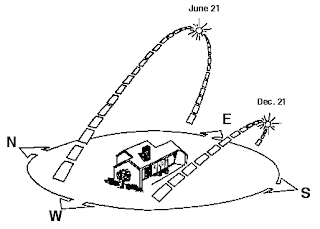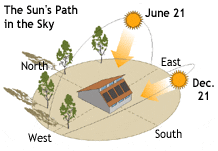A green building is designed to conserve resources and reduce negative impacts on the environment - whether it is energy, water, building materials or land. Compared to conventional construction, green buildings may use one or more renewable energy systems for heating and cooling, such as solar electric, solar hot water, geothermal, bio mass, or any combination of these.
Green Design for Sustainable environment
This is a term used in the building, furnishings, and product industries to indicate design sensitive to environmental-friendly, ecological issues.
Sustainability design components towards achieving ZERO ENERGY ARCHITECTURE
1. Regional aspects, climatic response, Building Orientation and Massing
2. Site Specific criteria & use of recycled materials
3. Selection of Spatial Elements and Materials for Distribution centre Ware House Design for Passive Architectural Energy for cooling
4. Ventilation for indoor Environment
5. Energy Efficiency/conservation – Lighting
6. Selection of Construction Materials (Sustainable)
7. Energy Efficient Landscape Design & Native planting, Pathways, Green roof
8. Waste Water for recycling & Rainwater harvesting
1. Regional aspects, climatic response, Building Orientation and Massing
For hot humid climate like India
2. Site specific criteria & use of recycled materials
Site specific Eco-system that can filter and oxygenate the air supply, retain water and replenish ground water and provide ambient cooling to the building should be studied in advance to work out appropriate Architectural design. Focus can also be given to increase the use the recycled materials in site finishes and furniture for the project. Architectural design can explore the possibility of shaded and landscaped areas to enhance the fresh air ventilation strategies and water reuse/reduction strategies. Green areas can be introduced more and parking/vehicular interference can be minimized.
3. Selection of Spatial Elements and Materials for Distribution centre Ware House and associated Building Design for Passive Architectural Energy for cooling
Use of spatial elements like courtyards, corridors, pergolas, breathing membrane or screens can be encouraged to achieve sustainable design. Cluster formation around shaded green areas, Introduction of corridor space towards sun exposed external edge of the building help to keep inside temperature to minimum compared to the conventional model of warehouse design. Courtyard can also be introduced in design as a ‘light well’ to provide natural light to adjoining spaces and can also work as a traditional gathering space. Courtyards also help to stack the ventilation by providing cool air to the adjoining spaces with relieving hot/used air. Wind towers are also in a way transformation of such spaces for the purpose of ventilation. These help very well to ‘catch’ air, reduce the temperature of air by cooling it down as the heavy cool air tends to pass down. This air can be supplied to air handling units that can substantially reduce the load on the HVAC systems. These spatial elements should be introduced in architectural design and detailing with the help of modern technological innovations. As the Ware house Building cooling load can be determined at design stage itself, architectural mass, size and proper orientation will help to reduce the cooling load by appropriate design options. Passive cooling can be introduced for sustainability.
4. Ventilation for Indoor Environment
These can effectively reduce difference in temperature inside and outside the Ware house to improve working environment inside and for advance work Efficiency.
5. Energy Efficiency/conservation – Lighting
6. Selection of construction materials (Sustainable)
Construction materials and other materials are selected wherever possible to have a low embodied energy, a recycled content and a potential for recycling in future. The interior finishes of the building are selected to support clean air initiatives.
7. Energy efficient Landscape design & Native planting, Pathways, Green roof
Energy efficient landscape design can be proposed for the purpose of conserving energy. As far as possible native plantation based on the location of site should be encouraged. Trees with more shaded space should be used to reduce the cooling costs. Trees can create ‘windbreaks’ to slow winds near buildings to prevent heat loss inside the buildings. Where there is a contoured site, Buildings can be positioned to take maximum advantage of natural landforms to work as windbreaks. These should also encourage ‘ Earth sheltering’ for the creation of shaded spaces as per design requirements. Green roof concept can be adopted to cool the buildings with extra thermal mass. Landscape design can include local materials, on-site composting and chipping to reduce green waste hauling, hand tools instead of gasoline-powered and also may involve using drought-resistant planting in arid areas, buying stock from local growers to avoid energy in transportation. Special site features are introduced for their potential to enhance the sustainability of the project. Natural waterways, forested areas and fields may provide cooling, water filtration and fresh air. Introducing filtration ponds can reduce pollution from paved area run off.
8. Rain water harvesting & waste water recycling
Rainwater harvesting can reduce potable water demands. As large roof areas can be possible source for the collection of rain waters, this can be harvested and used as an alternate source for toilet flushing and landscape irrigation. This cal also be used for the storage requirement for any proposed on site fire-fighting water tanks. Water sensitive design can also aim to manage storm water by reducing run – off increasing water storage on site facilitating infiltration on to the ground and encouraging conveyance of storm water in a way that more accurately replicates the natural system. This also increases permeable surfaces. Natural ground can also act as a natural filtration medium to store the rainwater. For this, the site slope is worked out by creating artificial ponds on site to act as possible collecting mediums. Some species of plants can also work as filtration medium and also holds soil to prevent the soil erosion. This system can also be used to collect and re-use water from vehicle wash which is a major activity for Distribution Centre heavy traffic systems. Low flush toilet system can also save on water required. On site foul treatment plan can be introduced so that all foul water can be treated on site and discharged on site.




No comments:
Post a Comment